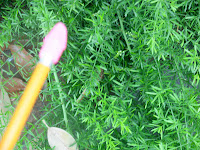
1. R-strategist- A mosquito is a R-strategist because it goes through development quickly and has more offspring at one time and more often than the K-strategists.

2. K-strategist- Humans are K-strategists because we go through development much slower compared to the R-strategists and our reproduction rate is slower as most people only have one baby at a time.
3. Anther and Filament of Stamen- This rose contains the anther and filament which is the male organ of a flower. The anther contains the pollen and when the pollen matures, the anther rips and releases the pollen.
4. Autotroph- Plants are autotrophs because they take energy from the environment and the sun (photosynthesis) to live. They are the producers in the food chain.
5. Connective Tissue- Cartilage is a connective tissue because it adds support, surrounds and connects to the body.

6. Animal That Has A Segmented Body- This bug has a segmented body. Meaning that, on the outside, the bug looks like it have different sections of the body on the outside

7. Unicellular Organism- An unfertilized egg is a unicellular organism. Unicellular organisms consist of just a single cell.
8.Endotherm- This goat (as well as my sisters) are endotherms, meaning that they are "warm-blooded." Organisms like these generate heat to maintain their body temperature.
9. Ectotherm- These turtle are ectotherms, meaning that the organism regulates its body temperature by exchanging heat with the surroundings. Ectotherms are also referred to as "cold-blooded."
10. Frond- A frond is a leaf-like structure of a fern. It is usually a large leaf with many divisions.
11. Pollination- This insect helps with the process of pollination by taking a flower's pollen on its legs and carrying it some distance to the next flower so that reproduction can occur.
12. Mutualism- Mutualism is a biological relationship where each individual cooperates with the other and both get something in return. The horse provides transportation for the human in return for the human providing food and shelter for the horse.
13. Parasitism- Parasitism is a relationship where one organism is taken advantage of while the other gets little or nothing in return. The mosquito takes a human's blood and uses it for its own benefit while the human is left with a gross red and itchy circle.
14. Gymnosperm Cone- One part of a gymnosperm. A gymnosperm is a plant whose seeds are not in an ovary and, in this particular case, are actually in a cone.











Great work. Please expand on your definitions for the next post. You are doing well, but I would like to see a little more information. I hope you bring your "guest pencil" to class on the first day!
ReplyDeleteKeep up the great work!